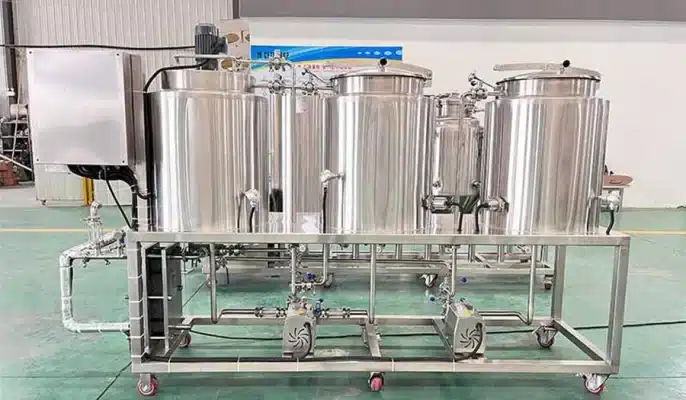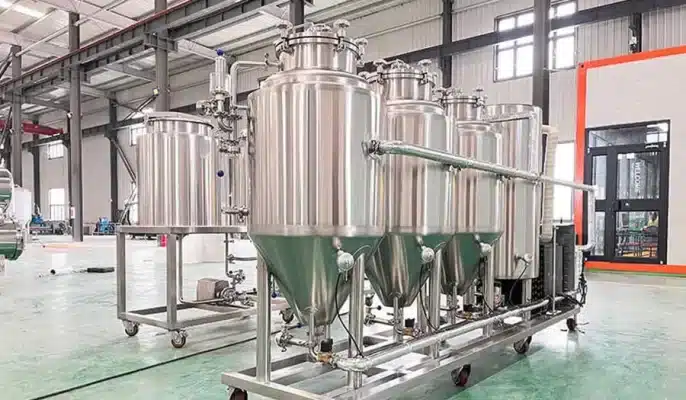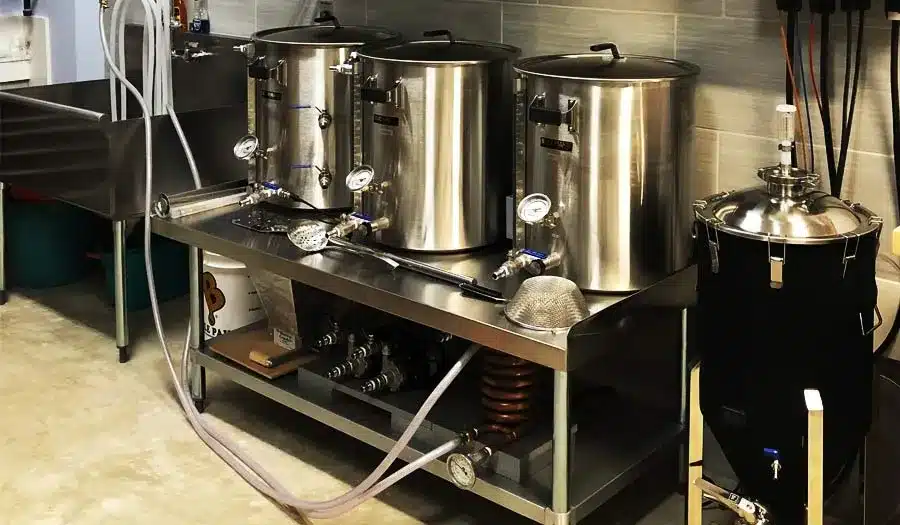Мини-пивоварни появились в последние годы, поскольку люди стремятся к ручной технике пивоварения и уникальным вкусам. По сравнению с крупными промышленными пивоварнями, мини-пивоварни могут не только предложить разнообразную и персонализированную продукцию, но и привнести в жизнь потребителя человеческий опыт. Однако оборудование и технологии, необходимые для успешного создания мини-пивоварни, являются важными факторами, которые многие предприниматели упускают из виду. В этой статье мы рассмотрим основные виды оборудования для мини-пивоварен, включая его функции.
Что такое мини-пивоварня?
Мини-система для варки пива - это, по сути, уменьшенная версия коммерческой пивоварни. Разработанные для личного использования, эти системы позволяют пивоварам и любителям крафтового пива варить свое пиво дома. Они бывают разных размеров, но обычно достаточно компактны, чтобы поместиться на кухонном столе или в небольшом складском помещении.
Состоящие из различных компонентов, таких как ферментеры, охладители сусла, варочные чайники и т. д., эти системы призваны упростить процесс пивоварения. В то время как крупное оборудование для пивоварения требует много места и инвестиций, мини-системы разработаны по более доступной цене и просты в использовании, что делает их доступными как для начинающих, так и для опытных пивоваров.

Что такое мини-пивоварня?
- Заторный тун: Емкость, используемая для затирания зерна с целью извлечения сахаров. Для сохранения тепла обычно используется изоляция.
- Бочка для затирания: Затирание - важнейший этап процесса мини-пивоварения, в ходе которого крахмал, содержащийся в сырье, преобразуется в ферментируемые сахара. Бочки для затирания обычно изготавливаются из нержавеющей стали и обладают хорошими теплоизоляционными свойствами.
- Бочка для брожения: Незаменимый элемент оборудования для небольших пивоварен. Его основная функция - создание замкнутой среды, в которой дрожжи могут проявлять активность и завершать процесс брожения. Материалом для изготовления бочки для брожения обычно служит нержавеющая сталь или пищевой пластик, что обеспечивает гигиеничность и устойчивость к коррозии.
- Охладитель сусла: Перед началом брожения сусло необходимо охладить до температуры, подходящей для размножения дрожжей, и охладитель в этот момент особенно важен. Обычно используются пластинчатые и трубчатые охладители.
- Фильтр: После завершения брожения в вине часто остается дрожжевой осадок и твердые частицы. Использование фильтров позволяет эффективно удалить эти примеси. Существует множество типов фильтров, включая фильтры грубой и тонкой очистки.
- Шлюз: Небольшое устройство, которое предотвращает попадание воздуха в пиво во время брожения.
- Гидрометр: Инструмент для измерения плотности сусла и отслеживания хода брожения.
- Термометр: Инструмент для отслеживания температуры на этапах затирания и кипячения.
- Чистящее оборудование: Чистая среда - важный залог производства высококачественного вина, поэтому без соответствующего оборудования для очистки не обойтись. Обычно это водяные пистолеты высокого давления, системы распыления чистящих средств и т. д.
Мини-пивоварня Процесс пивоварения
- Затирание: Затирание - это процесс замачивания измельченных зерен в горячей воде для активации ферментов, которые превращают крахмал в ферментируемые сахара. Сусло выдерживают в определенном температурном диапазоне (обычно 150-160°F) в течение часа, чтобы полностью растворить сахара.
- Кипячение: После затирания полученную жидкость (так называемое сусло) кипятят. Этот этап необходим для стерилизации смеси и добавления хмеля, который придает пиву горечь, вкус и аромат. В зависимости от рецепта, хмель можно добавлять в разные моменты процесса кипячения для достижения различных вкусов.
- Охлаждение: После того как сусло закипело, его нужно быстро охладить до температуры, подходящей для брожения дрожжей (обычно около 70°F). Вот тут-то и пригодится охладитель сусла. Быстрое охлаждение помогает предотвратить заражение дикими бактериями и дрожжами.
- Брожение: Охлажденное сусло переливают в бродильную емкость и добавляют дрожжи. Брожение - это этап, на котором дрожжи потребляют сахара и превращают их в алкоголь и углекислый газ. Брожение может длиться от недели до нескольких месяцев, в зависимости от стиля пива.
- Бутилирование/кегирование: После завершения брожения пиво разливают по бутылкам или кегам. Некоторые пивовары также могут карбонизировать пиво на этом этапе, добавляя небольшое количество сахара перед закупоркой бутылки или используя баллончики с CO2 для кег.
- Карбонизация: После розлива в бутылки или кеги пиву необходимо время для карбонизации и созревания. В зависимости от стиля пива это может занять от нескольких недель до месяца.
Как поддерживать оборудование для минипивоварен?
- Очистка и дезинфекция: После каждого использования тщательно очищайте все оборудование с помощью подходящего чистящего средства. Дезинфицируйте все оборудование перед использованием, чтобы предотвратить загрязнение. Используйте несмываемое дезинфицирующее средство в соответствии с инструкциями производителя.
- Пивные чайники и бочки для сусла: Почистите и вымойте внутренние поверхности пивных чайников и бочек для сусла, чтобы удалить все остатки. Проверьте, нет ли пригоревших остатков, и очистите их подходящим чистящим средством. Проверьте нагревательные элементы на наличие накипи и очистите их при необходимости.
- Ферментеры: После каждого использования очищайте и дезинфицируйте ферментеры. Проверьте, нет ли царапин или других дефектов, в которых могут завестись бактерии. Если прокладки или уплотнения имеют признаки износа, замените их.
- Шлюзы и пробки: Перед использованием очистите и продезинфицируйте воздушные замки и заглушки. Проверьте, нет ли трещин или повреждений, и при необходимости замените их.
- Сифон и оборудование для подачи: Перед каждым использованием очищайте и дезинфицируйте сифонное оборудование. Проверяйте трубы на наличие признаков износа или обесцвечивания. Регулярно заменяйте трубы, чтобы предотвратить рост бактерий.
- Бутылки и крышки: Перед розливом тщательно очистите и простерилизуйте бутылки. Проверьте бутылки на наличие трещин или сколов и выбросьте их, если они повреждены. Проверьте крышки на наличие деформации и при необходимости замените.
- Регулярная очистка: После каждой варки необходимо сразу же очищать оборудование, чтобы предотвратить накопление дрожжей и остатков. Сюда входят емкости для брожения, затирания, фильтры и т.д.
Преимущества и недостатки мини-пивоварения
|
АДВАНТАЖИ |
ОТЗЫВЫ |
|
Компактный и легко помещается в небольших помещениях. |
Ограниченная мощность варки по сравнению с коммерческими системами. |
|
Недорогой и доступный для начинающих. |
Может не обладать расширенными возможностями для опытных пивоваров. |
|
Упрощает процесс заваривания, делая его легким для любого человека. |
Некоторые системы требуют дополнительных покупок для настройки. |
|
Можно производить высококачественное пиво в домашних условиях. |
Обслуживание может отнимать много времени, особенно если речь идет о больших системах. |

ЧАСТО ЗАДАВАЕМЫЕ ВОПРОСЫ
Что такое мини пивоваренная система?
Мини-пивоваренная система - это устройство, предназначенное для небольших пивоварен, обычно включающее в себя сусловарение, брожение, фильтрацию, охлаждение и другие функции. Она представляет собой комплексное решение для пивоварения, подходящее для небольших пивоварен или домашнего использования.
Какова мощность мини пивоваренной системы?
Объем мини пивоваренной системы зависит от марки и модели и обычно составляет от нескольких литров до сотен литров. Обычное оборудование для домашнего использования обычно составляет от 20 до 50 литров, а небольшое коммерческое оборудование может достигать 200 литров.
Где можно купить оборудование для мини пивоваренной системы?
Оборудование для мини пивоваренной системы можно приобрести в специализированных магазинах пивоваренного оборудования или у специализированных поставщиков материалов для пивоварения, чтобы узнать бренд и отзывы, чтобы убедиться в качестве продукции. Конечно, вы также можете связаться с Micet Group напрямую.
Можно ли настроить мою мини пивоваренную систему?
Да, многие поставщики предлагают возможность индивидуальной настройки, и Micet Group предоставляет такую услугу, особенно для продвинутых моделей.




